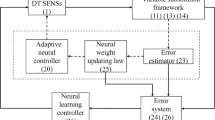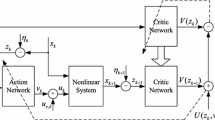Abstract
This paper presents a novel control and identification scheme based on adaptive dynamic programming for nonlinear dynamical systems. The aim of control in this paper is to make output of the plant to follow the desired reference trajectory. The dynamics of plants are assumed to be unknown, and to tackle the problem of unknown plant’s dynamics, parameter variations and disturbance signal effects, a separate neural network-based identification model is set up which will work in parallel to the plant and the control scheme. Weights update equations of all neural networks present in the proposed scheme are derived using both gradient descent (GD) and Lyapunov stability (LS) criterion methods. Stability proof of LS-based algorithm is also given. Weight update equations derived using LS criterion ensure the global stability of the system, whereas those obtained through GD principle do not. Further, adaptive learning rate is employed in weight update equation instead of constant one in order to have fast learning of weight vectors. Also, LS- and GD-based weight update equations are also tested against parameter variation and disturbance signal. Three nonlinear dynamical systems (of different complexity) including the forced rigid pendulum trajectory control are used in this paper on which the proposed scheme is applied. The results obtained with LS method are found more accurate than those obtained with the GD-based method.























Similar content being viewed by others
References
Abu-Khalaf M, Lewis FL (2005) Nearly optimal control laws for nonlinear systems with saturating actuators using a neural network hjb approach. Automatica 41(5):779–791
Aguilar-Leal O, Fuentes-Aguilar R, Chairez I, García-González A, Huegel J (2016) Distributed parameter system identification using finite element differential neural networks. Appl Soft Comput 43:633–642
Al-Tamimi A, Lewis FL, Abu-Khalaf M (2008) Discrete-time nonlinear hjb solution using approximate dynamic programming: convergence proof. IEEE Trans Syst Man Cybern Part B Cybern 38(4):943–949
Balakrishnan S, Biega V (1996) Adaptive-critic-based neural networks for aircraft optimal control. J Guid Control Dyn 19(4):893–898
Becker S, Le Cun Y (1988) Improving the convergence of back-propagation learning with second order methods. In: Proceedings of the 1988 connectionist models summer school. Morgan Kaufmann, San Matteo, pp 29–37
Bellman R (1957) Dynamic programming. Princeton university press, Princeton
Bertsekas DP (2011) Temporal difference methods for general projected equations. IEEE Trans Autom Control 56(9):2128–2139
Bertsekas DP, Tsitsiklis JN (1995) Neuro-dynamic programming: an overview. In: Proceedings of the 34th IEEE conference on decision and control, 1995, vol 1. IEEE, pp 560–564
Bhuvaneswari N, Uma G, Rangaswamy T (2009) Adaptive and optimal control of a non-linear process using intelligent controllers. Appl Soft Comput 9(1):182–190
Castillo O, Melin P (2003) Intelligent adaptive model-based control of robotic dynamic systems with a hybrid fuzzy-neural approach. Appl Soft Comput 3(4):363–378
Chen CW (2011) Stability analysis and robustness design of nonlinear systems: an nn-based approach. Appl Soft Comput 11(2):2735–2742
Denaï MA, Palis F, Zeghbib A (2007) Modeling and control of non-linear systems using soft computing techniques. Appl Soft Comput 7(3):728–738
Dong L, Zhong X, Sun C, He H (2016) Adaptive event-triggered control based on heuristic dynamic programming for nonlinear discrete-time systems
Dreyfus SE, Law AM (1977) Art and theory of dynamic programming. Academic Press, Inc, Cambridge
Franzini M et al (1987) Speech recognition with back-propagation. In: Proceedings, 9th annual conference of IEEE engineering in medicine and biology society
Gao W, Jiang ZP (2015) Global optimal output regulation of partially linear systems via robust adaptive dynamic programming. IFAC-PapersOnLine 48(11):742–747
Gao W, Jiang Y, Jiang ZP, Chai T (2016) Output-feedback adaptive optimal control of interconnected systems based on robust adaptive dynamic programming. Automatica 72:37–45
Hendzel Z, Szuster M (2011) Discrete neural dynamic programming in wheeled mobile robot control. Commun Nonlinear Sci Numer Simul 16(5):2355–2362
Jiang Y, Jiang ZP (2014) Robust adaptive dynamic programming and feedback stabilization of nonlinear systems. IEEE Trans Neural Netw Learn Syst 25(5):882–893
Jin N, Liu D, Huang T, Pang Z (2007) Discrete-time adaptive dynamic programming using wavelet basis function neural networks. In: IEEE international symposium on approximate dynamic programming and reinforcement learning, (2007). ADPRL 2007. IEEE, pp 135–142
Lewis FL, Vrabie D (2009) Reinforcement learning and adaptive dynamic programming for feedback control. IEEE Circuits Syst Mag 9(3):32–50
Lilly JH (2011) Fuzzy control and identification. Wiley, New York City
Liu D, Wei Q (2014) Policy iteration adaptive dynamic programming algorithm for discrete-time nonlinear systems. IEEE Trans Neural Netw Learn Syst 25(3):621–634
Liu D, Wang D, Yang X (2013) An iterative adaptive dynamic programming algorithm for optimal control of unknown discrete-time nonlinear systems with constrained inputs. Inf Sci 220:331–342
Liu D, Wang D, Li H (2014) Decentralized stabilization for a class of continuous-time nonlinear interconnected systems using online learning optimal control approach. IEEE Trans Neural Netw Learn Syst 25(2):418–428
Ljung L (1998) System identification. Springer, Ne York
Man Z, Lee K, Wang D, Cao Z, Miao C (2011) A new robust training algorithm for a class of single-hidden layer feedforward neural networks. Neurocomputing 74(16):2491–2501
Narendra KS, Parthasarathy K (1990) Identification and control of dynamical systems using neural networks. IEEE Trans Neural Netw 1(1):4–27
Ni Z, He H (2013) Heuristic dynamic programming with internal goal representation. Soft Comput 17(11):2101–2108
Petrosian A, Prokhorov D, Homan R, Dasheiff R, Wunsch D (2000) Recurrent neural network based prediction of epileptic seizures in intra-and extracranial eeg. Neurocomputing 30(1):201–218
Prokhorov DV, Wunsch DC et al (1997) Adaptive critic designs. IEEE Trans Neural Netw 8(5):997–1007
Si J, Wang YT (2001) Online learning control by association and reinforcement. IEEE Trans Neural Netw 12(2):264–276
Singh M, Srivastava S, Gupta J, Handmandlu M (2007) Identification and control of a nonlinear system using neural networks by extracting the system dynamics. IETE J Res 53(1):43–50
Song R, Zhang H, Luo Y, Wei Q (2010) Optimal control laws for time-delay systems with saturating actuators based on heuristic dynamic programming. Neurocomputing 73(16):3020–3027
Song R, Xiao W, Zhang H (2013) Multi-objective optimal control for a class of unknown nonlinear systems based on finite-approximation-error adp algorithm. Neurocomputing 119:212–221
Song R, Lewis FL, Wei Q, Zhang H (2016) Off-policy actor-critic structure for optimal control of unknown systems with disturbances. IEEE Trans Cybern 46(5):1041–1050
Srivastava S, Singh M, Hanmandlu M (2002) Control and identification of non-linear systems affected by noise using wavelet network. In: Computational intelligence and applications. Dynamic Publishers, Inc., pp 51–56
Srivastava S, Singh M, Hanmandlu M, Jha AN (2005) New fuzzy wavelet neural networks for system identification and control. Appl Soft Comput 6(1):1–17
Tutunji TA (2016) Parametric system identification using neural networks. Appl Soft Comput 47:251
Vamvoudakis KG, Lewis FL (2010) Online actor-critic algorithm to solve the continuous-time infinite horizon optimal control problem. Automatica 46(5):878–888
Visnevski NA (1997) Control of a nonlinear multivariable system with adaptive critic designs. PhD thesis, Texas Tech University
Vrabie D, Lewis F (2009) Neural network approach to continuous-time direct adaptive optimal control for partially unknown nonlinear systems. Neural Netw 22(3):237–246
Wang D, Liu D, Zhang Q, Zhao D (2016) Data-based adaptive critic designs for nonlinear robust optimal control with uncertain dynamics. IEEE Trans Syst Man Cybern Syst 46:1544
Watkins CJ, Dayan P (1992) Q-learning. Mach Learn 8(3–4):279–292
Werbos PJ (1992) Approximate dynamic programming for real-time control and neural modeling. Handb Intell Control Neural Fuzzy Adapt Approach 15:493–525
Xiao G, Zhang H, Luo Y (2015) Online optimal control of unknown discrete-time nonlinear systems by using time-based adaptive dynamic programming. Neurocomputing 165:163–170
Yang X, Liu D, Wei Q (2014) Online approximate optimal control for affine non-linear systems with unknown internal dynamics using adaptive dynamic programming. IET Control Theory Appl 8(16):1676–1688
Yang X, Liu D, Wei Q, Wang D (2016) Guaranteed cost neural tracking control for a class of uncertain nonlinear systems using adaptive dynamic programming. Neurocomputing 198:80–90
Zhang J, Zhang H, Luo Y, Feng T (2014) Model-free optimal control design for a class of linear discrete-time systems with multiple delays using adaptive dynamic programming. Neurocomputing 135:163–170
Zhu Y, Zhao D, Li X (2016) Iterative adaptive dynamic programming for solving unknown nonlinear zero-sum game based on online data
Acknowledgements
This study is not funded by any agency.
Author information
Authors and Affiliations
Corresponding author
Ethics declarations
Conflict of interest
Rajesh Kumar declares that he has no conflict of interest. Smriti Srivastava declares that she has no conflict of interest. J. R. P. Gupta declares that he has no conflict of interest.
Ethical approval
This article does not contain any studies with human participants or animals performed by any of the authors.
Additional information
Communicated by V. Loia.
Rights and permissions
About this article
Cite this article
Kumar, R., Srivastava, S. & Gupta, J.R.P. Lyapunov stability-based control and identification of nonlinear dynamical systems using adaptive dynamic programming. Soft Comput 21, 4465–4480 (2017). https://doi.org/10.1007/s00500-017-2500-3
Published:
Issue Date:
DOI: https://doi.org/10.1007/s00500-017-2500-3




